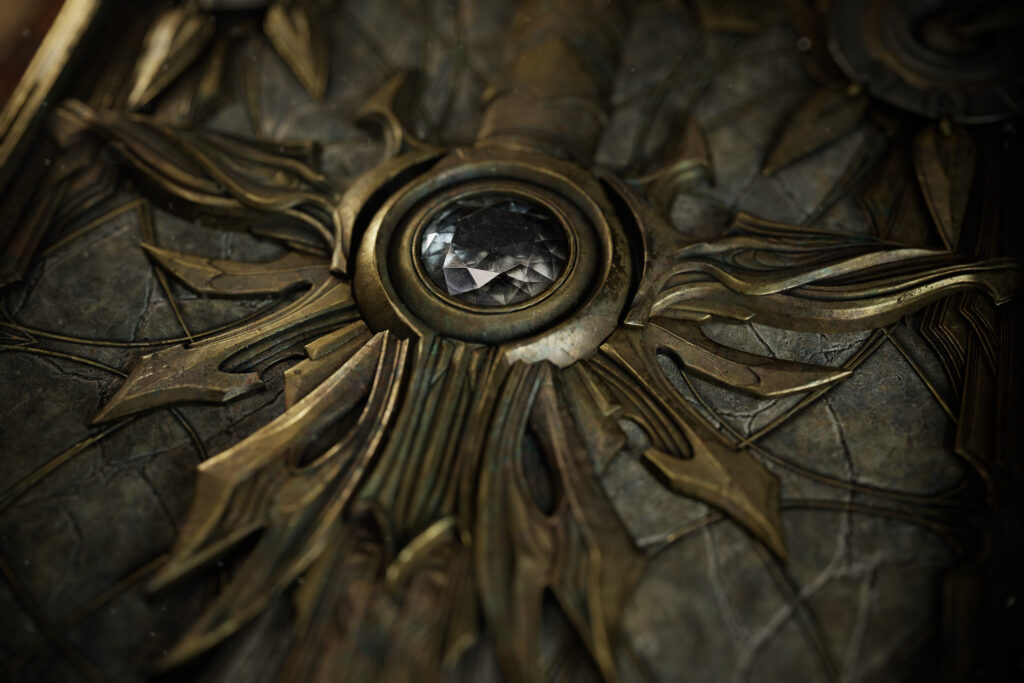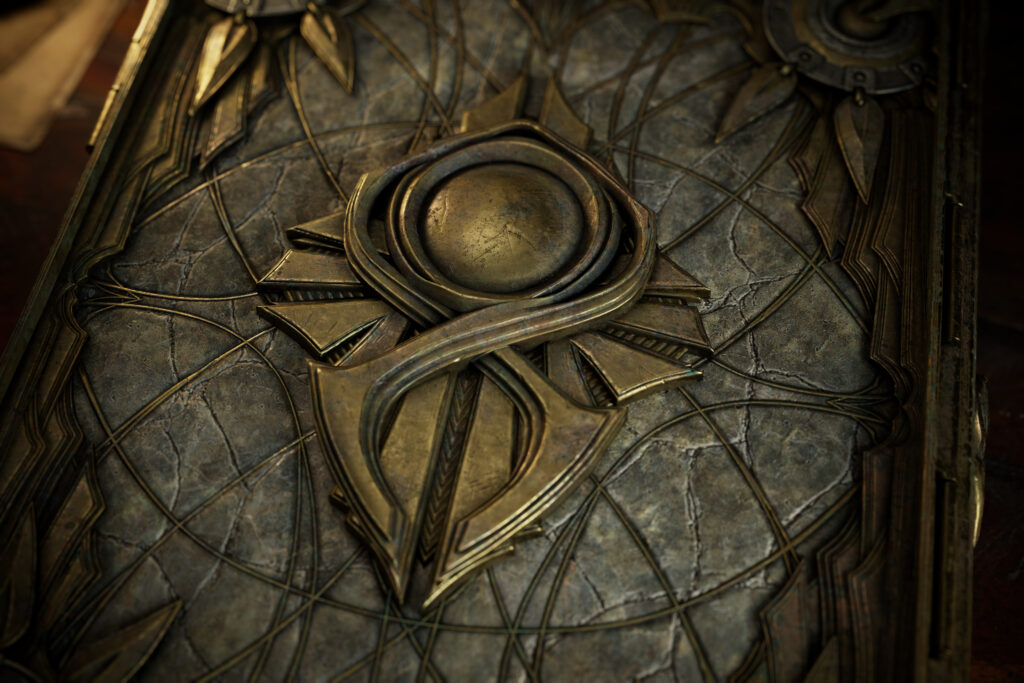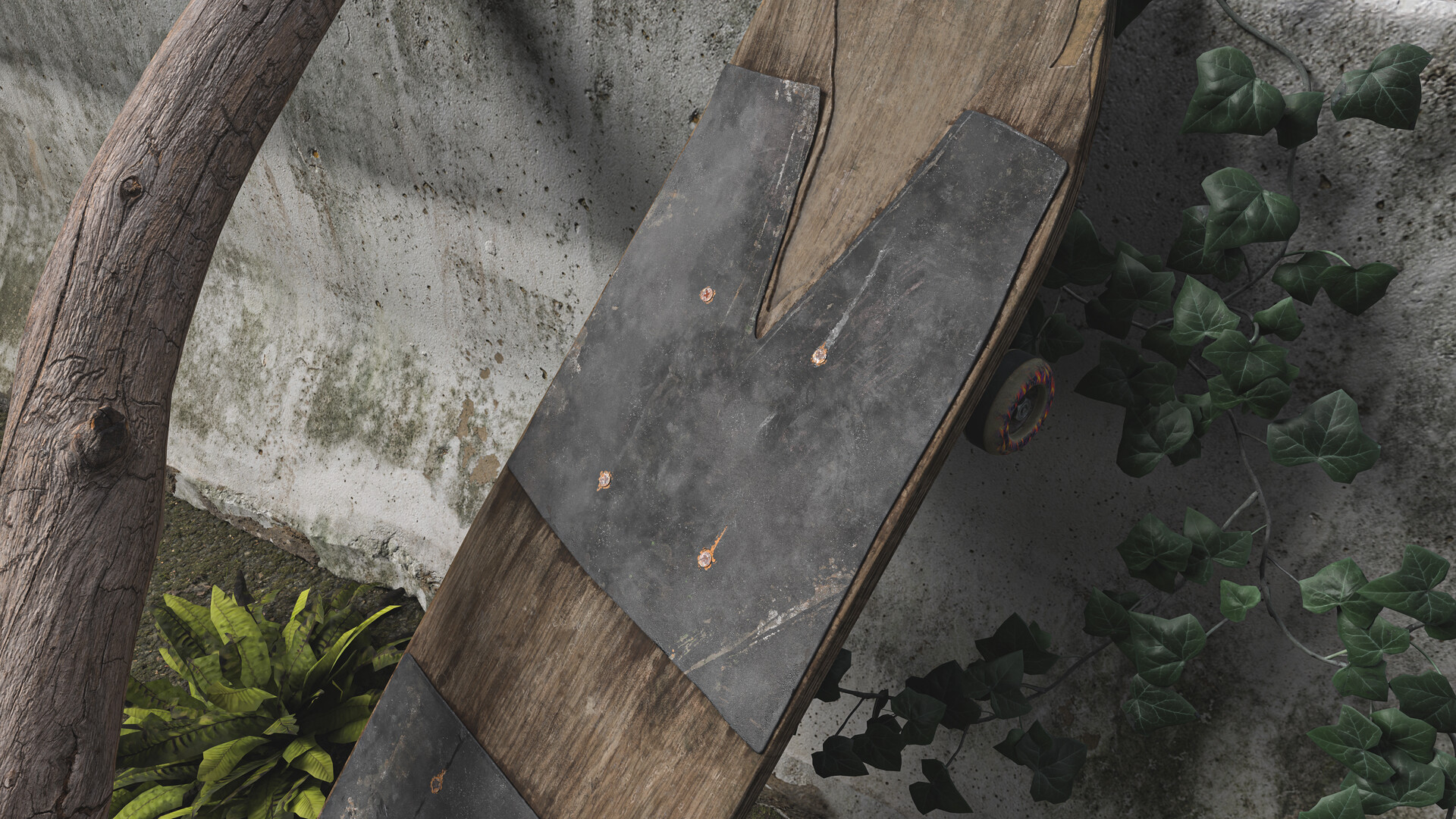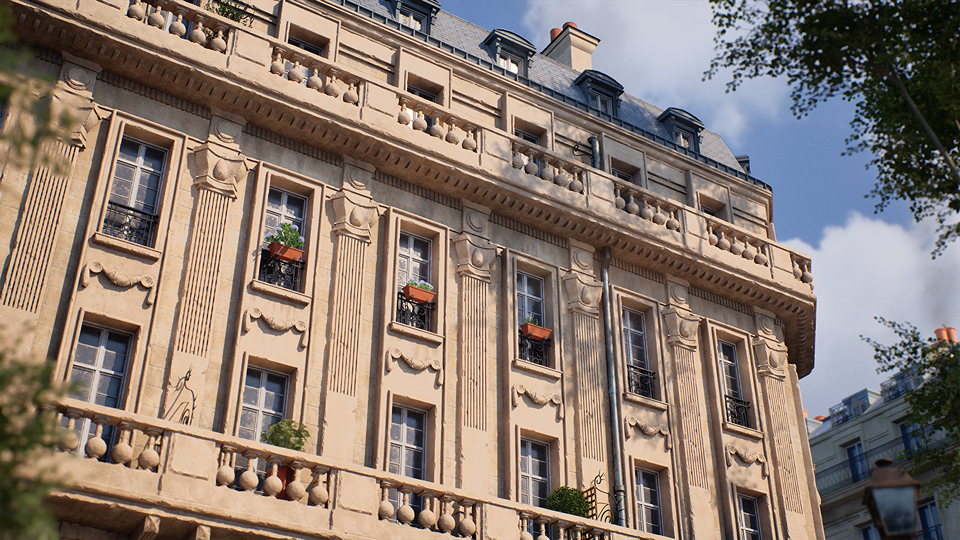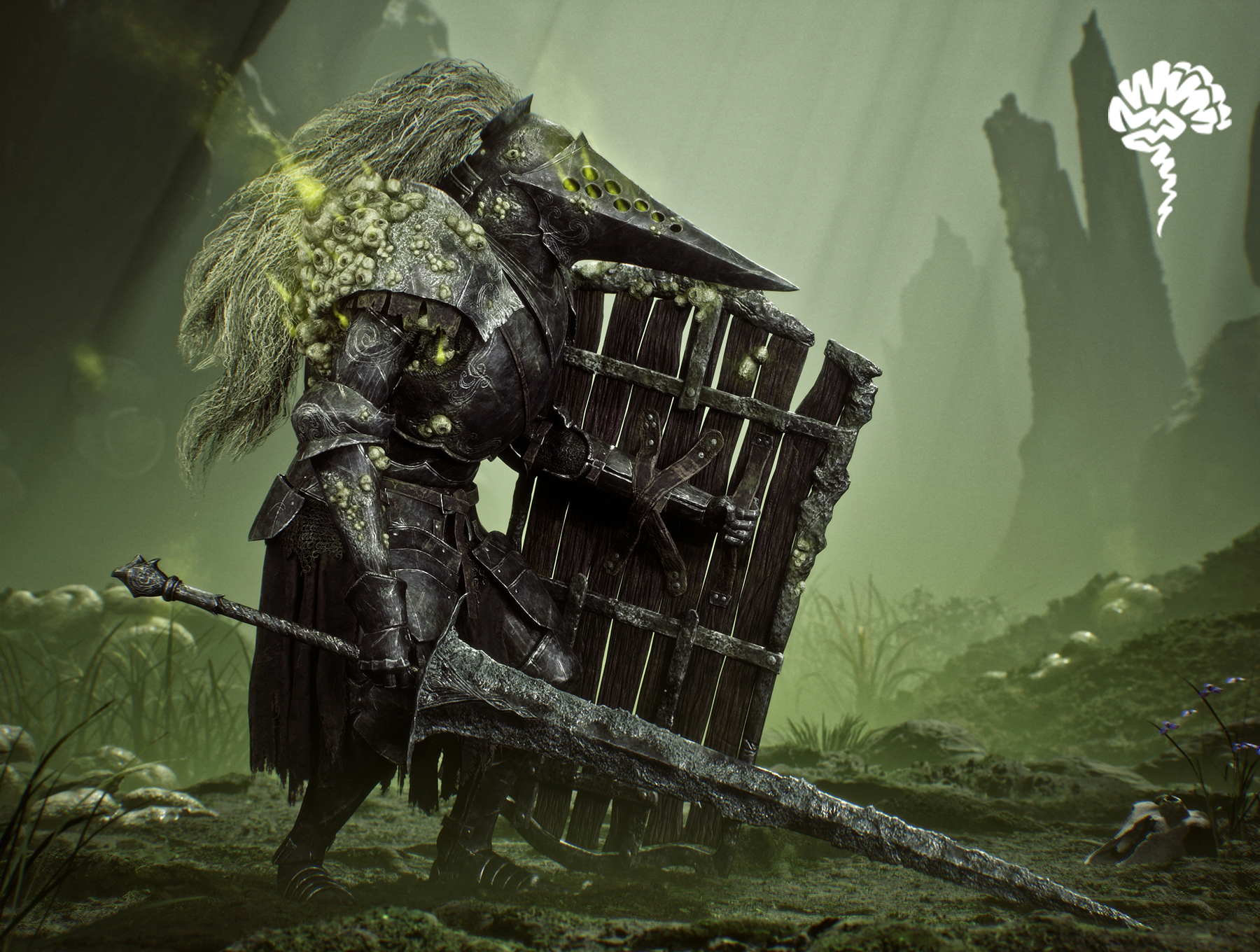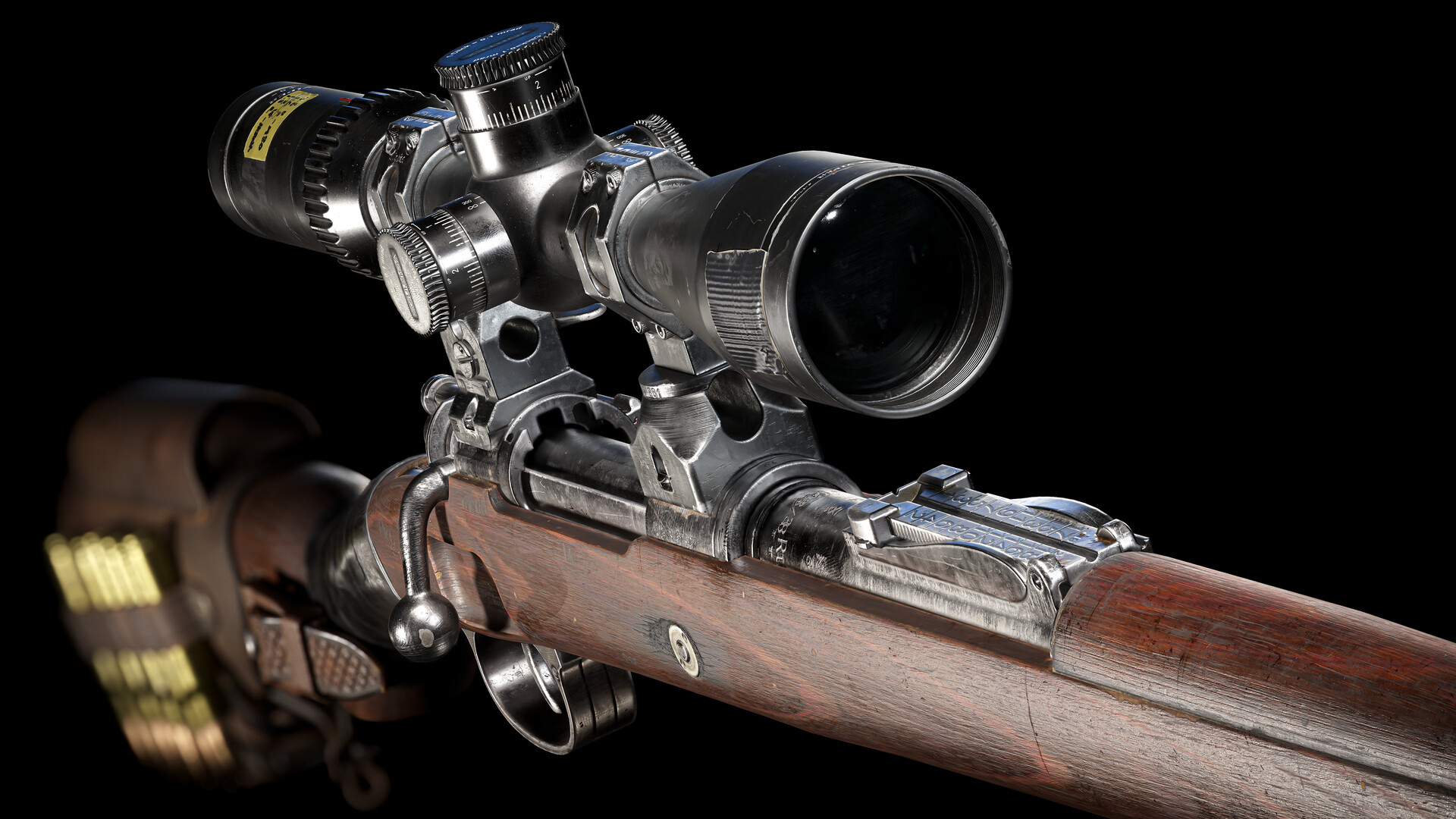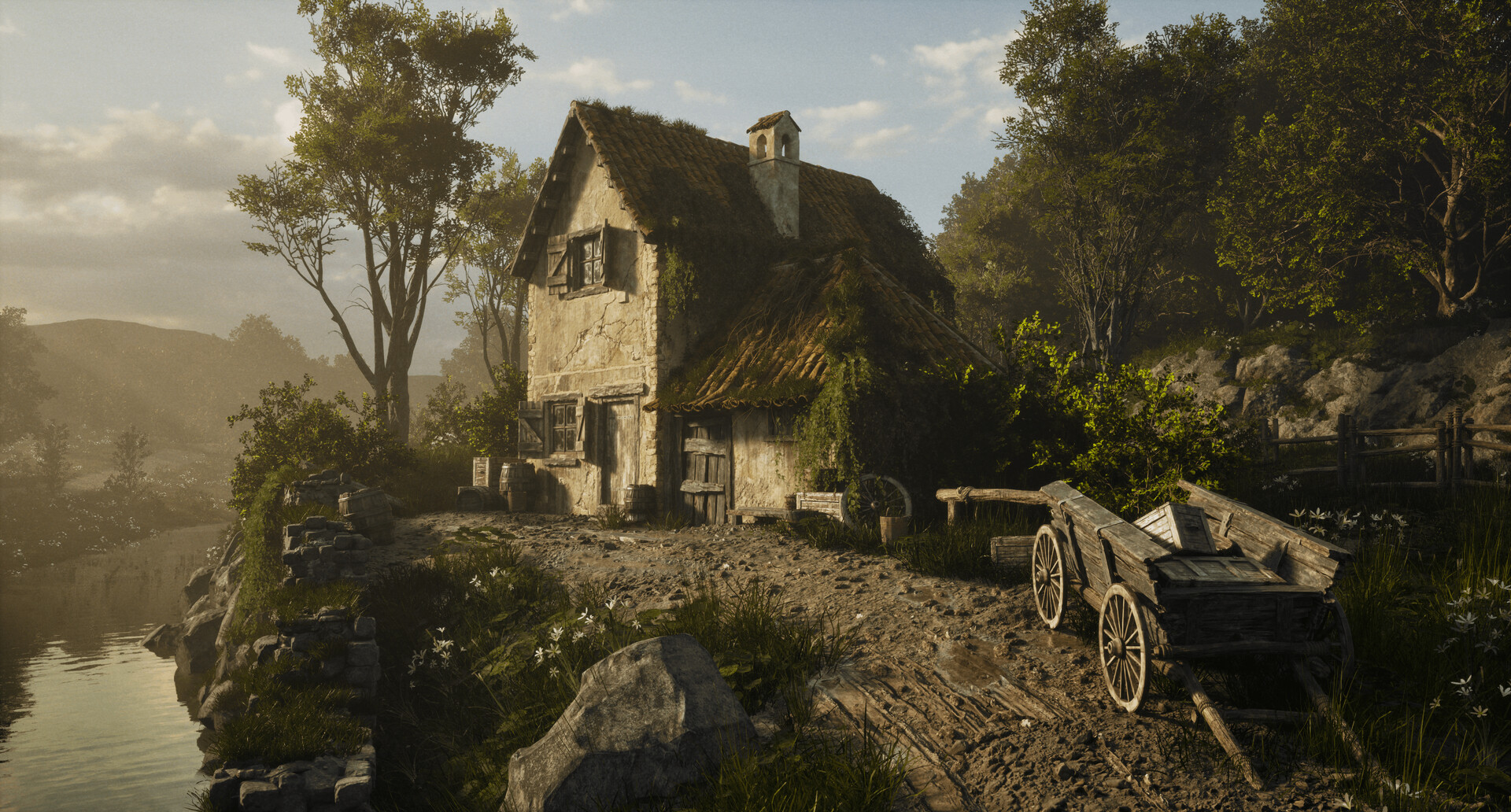Book of Tyrael
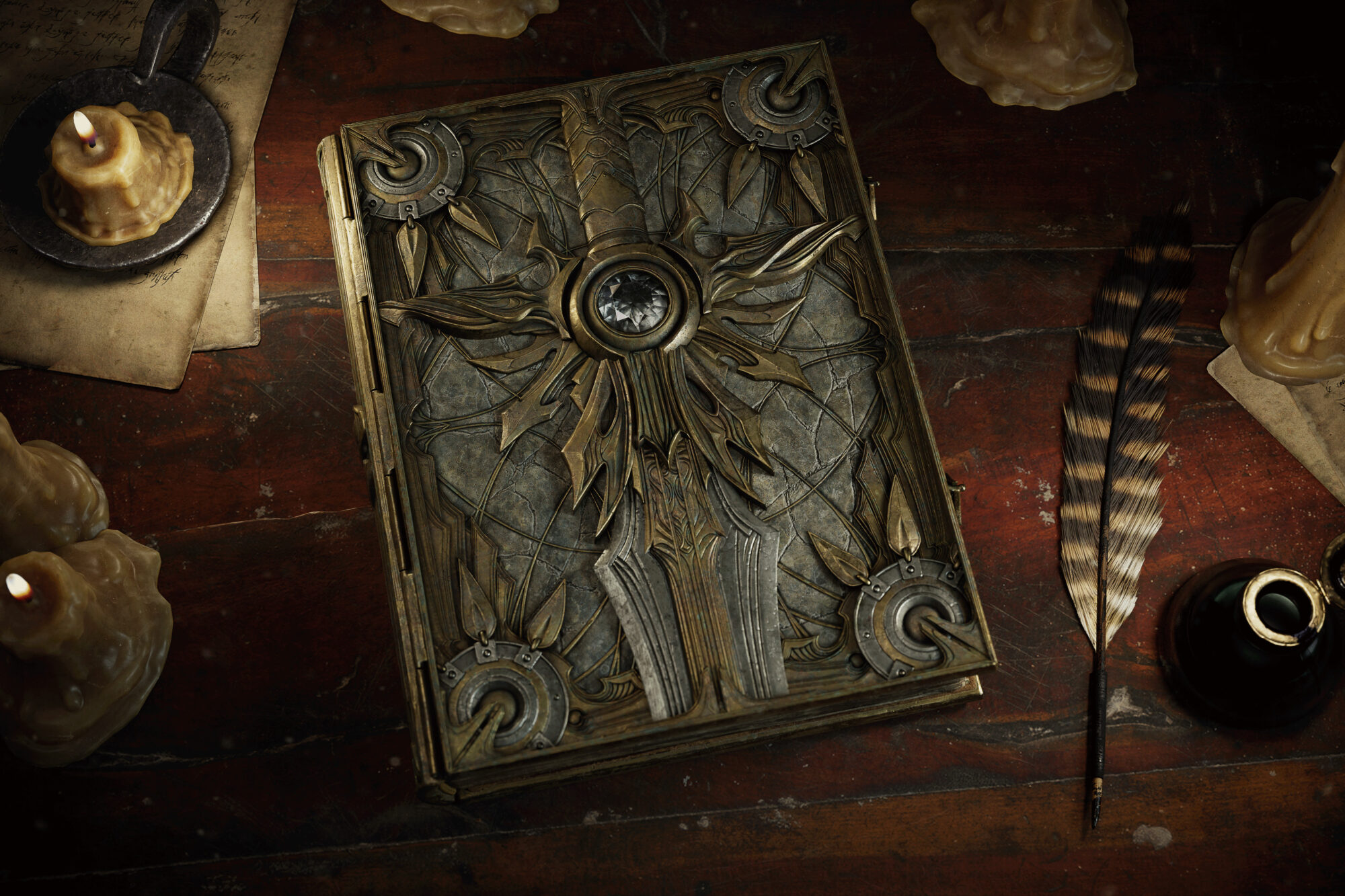

Introduction
Hi everyone! My name is Anton Yakovlev and I'm a Lead 3D Artist at Sperasoft Studio in St.Petersburg.
Goals
I have the honor of telling you about my latest artwork, The Book Of Tyrael. Like many fellow artists, I started my journey somewhere around high school. Being an avid World of Warcraft player at the time, I was thoroughly impressed by the works of Blizzard Art Directors and had spent many an hour looking at the artworks on the Sons Of The Storm website.
One such Art Director is Glenn Rane, who happens to be the author of the original design of the Book of Tyrael. I stumbled upon said book quite a long time ago, but being mostly interested in Character at the time, didn’t pay much attention to it.
Now that I’ve found myself gravitating towards Realistic Props and Environment art, this seemed like a perfect opportunity. Also, around the end of last year, I started actively learning Blender, kicking off the process with the outstanding Chamferzone M84 Grenade Tutorial, which I highly recommend. So one of the goals of this particular production was also Blender practice.
References
In both my professional work and personal projects, I firmly believe that good references are half the battle.
And the way I look for references as of late is pretty straightforward. I’ve taken to using Google’s advanced image search. I usually look for images above 2-4 Megapixels. Depending on the subject, I sometimes may find myself on a Web auction or online gallery.
They tend to post very high-resolution pictures, which are sometimes locked behind the code and are only available for viewing with a magnifying tool. Not gonna lie, I would screenshot and then collage a particularly good reference pic.
Also, if you struggle to find a good reference for a particular item or material, try looking for something alternative, which can represent a similar surface/details.
For instance, when I was working on a M84 Grenade, I struggled to find particularly good grenade references that would show material details, so I looked for old ammo crates, which tend to consist of kind of the same metal and are painted pretty similarly.
In general, I’d say, being able to problem solve creatively in more than one way is a very handy skill in art and in life.
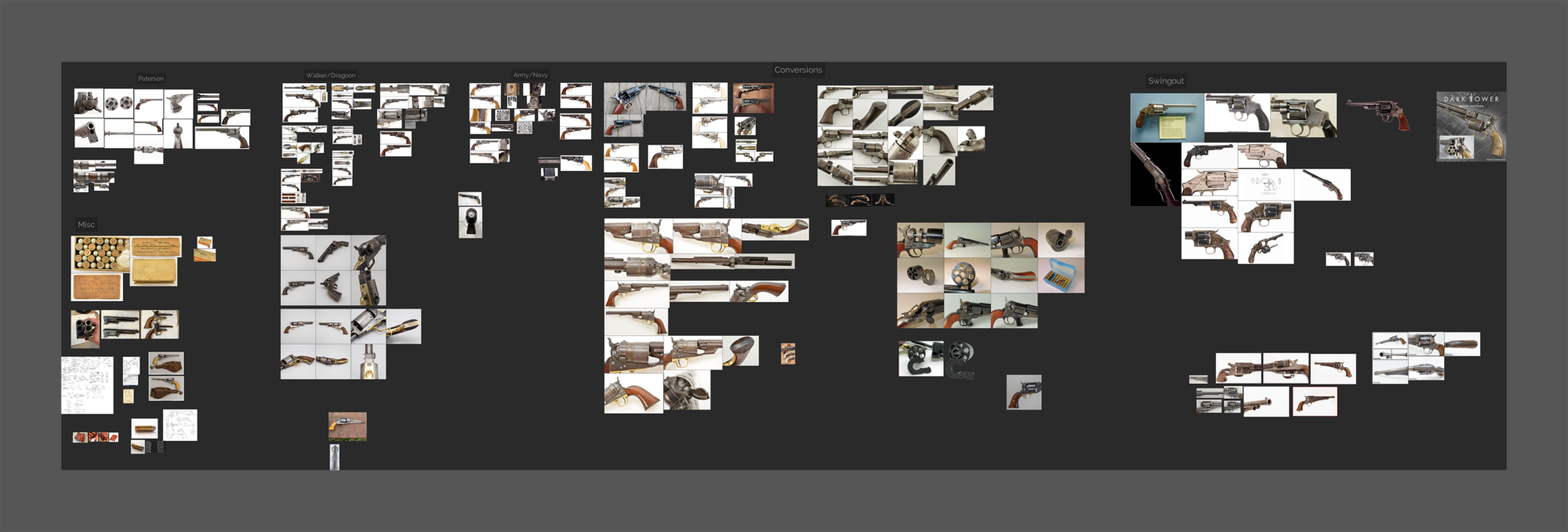

It’s important to note that not every picture has the same value in terms of reference, and it’s crucial to know what to look for. I’m going to talk about this in more detail in further chapters, so keep reading!
Modelling
As I’ve said before, one of the goals of this artwork was Blender practice. I’m a long-time Maya user and I’m much quicker with it, but I wanted to at least familiarize myself with the toolkit and establish some semblance of a workflow.
Granted, the concept is very symmetrical, so I used the Mirror modifier a lot, effectively modeling a quarter of the base cover and a half of each of the ornaments. Mirroring in Blender is much more convenient in comparison to Maya, or at least I’ve found it to be so.
I’ve also ended up working with the crease tool a lot, pretty much the same way I do in Maya. It’s the least destructive type of subdivision modeling; it allows you to be really flexible when it comes to edge thickness and provided you keep your subdivision level 1 topology clean, you can use it to drastically expedite the low poly stage.
- Below is my high poly modeling setup, with Mirror modifiers and creased edges.
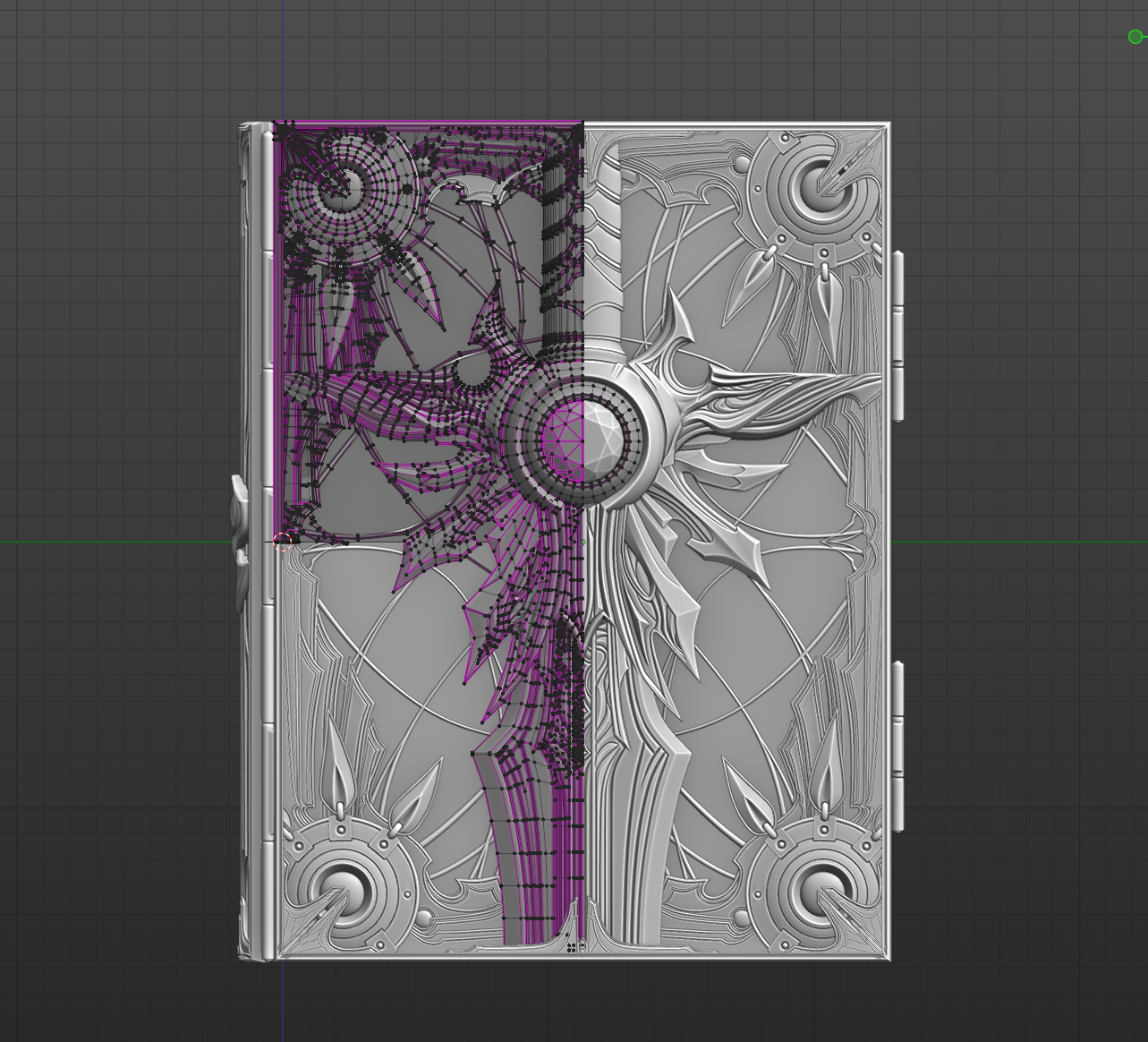
Speaking of edge thickness, when you’re working on your model, you need to keep in mind that material properties translate not only through textures but also through the model itself.
Every material, given the particular circumstances, such as age, surface treatment, production method, etc. Will display certain properties of hardness, fragility, or pliability, which in turn may translate into things such as edge thickness; the way damage scars the surface, what amount and which kinds of details are there. On top of that, from a strictly technical standpoint, you may want to keep your edges and details above a certain size.
At the end of the day, this is a graphic representation and it uses a Normal map. And using a Normal map only allows for so much detail fidelity. So in order to have an even remotely visible bevel, you need to reserve at least 2 pixels for its width. In order to have those 2 pixels after the bake, you need to have your edge above a certain level of sharpness.
Besides, realistic art is only borrowed from real life, and in real life, there are no infinitely small objects and no infinitely small bevels. Case in point, a diamond may have the most precise, perfectly sharp edges. But it would still catch some light on those edges, and using a model with hard edges and no normal map would create an unnatural representation that would look alien and fabricated.
- Below on the right, you can see a hard-edged diamond model without normal map.

This brings me to my next point. When working on high poly models or textures, one needs to pay attention to certain details. Each physical object behaves in a certain way and displays certain properties. We experience these properties in real life every day.
For example, you’d instantly recognize the way dirt and grime stick to glue residue after the careless removal of a sticker, or you’d immediately know when you see the way ink permeates the fibers of fabric after you’ve spilled it on your shirt.
Our very perception of life comprises these bits of experience. It’s literally how we tell stuff apart. I call them to experience anchors. They may be visual, as in cases that
I’ve described above, or sensory (feeling the crispness of fresh bed sheets or feeling the suction force when trying to lift a foot from the muddy ground) or audial (the way cork squeaks when you open a wine bottle or the way a pan lid may wobble in a circular motion before settling down if you drop it).
- Below are some examples of references I’d use.

This is kind of what I was alluding to in looking for certain things in references. You need to look for images that have those visual experience anchors. Having good examples and representing those anchors in a recognizable fashion is what, in my opinion, ties the artwork to real life and makes it believable.
At the end of the day, our goal as production artists is to make the viewer believe that what they see is real and tangible. That feeling of recognition is what you’re looking for. So if you want to make your worn metallic thing believable, look for worn metal, simple as that!
Try to analyze it and pinpoint things that distinguish it from, say, worn plastic or porcelain. Maybe this would even intersect with your own real-life experience. Maybe you’ve been walking along the roadside one day and saw a tin can, that was crumpled in a particular way, or you might have an antique candleholder that belonged to your grand-grandfather.
Maybe the candleholder was dropped a few times and has some dents. These are all sources of real-life experience. Analyze them, collect them, and use them.
UVs and Lowpoly
This part is fairly straightforward. I was on a pretty strict timeframe and decided to switch to Maya for retopology and UVs in the interest of expediency. Old habits die hard, and so in this case, I turned back to my roots.
I use the basic Maya Quad Draw Tool for Retopology and Maya’s UV editor to author my UVs. I’m a firm believer in working with barebones versions of software. It may be easy to take down a tree when you have your fancy state-of-the-art chainsaw, but when you find yourself wielding an axe, you might be in trouble.
So to reiterate, learn new things and customize at your heart’s content, but don’t forget to refresh the basics once in a while, should you find yourself in a new environment where you don’t have access to your personal setup.
As far as topology goes, one rule of thumb I always use for my students or for artists inside the studio when giving feedback is as follows: Geometry has to serve one of two purposes. It either affects silhouette or helps things deform properly during animation.
There are cases where you’d add geometry to be able to use vertex paint data more extensively, but I feel that’s a bit specific and mostly affects tiled modular structures.
Outside these items, you don’t really need to use more geometry than necessary. When inspecting the model, ask yourself whether your mesh would lose anything if optimized. If the answer is no, then go ahead and optimize it.
Of course, as with everything in this article, you have to take my point of view with a grain of salt and god knows I don’t adhere to this rule 100% of the time myself. But it’s a good reference for when in doubt.

This is by far my favorite part. I absolutely love analyzing references, breaking them down into parts, and trying to recreate those parts in order to create a feeling of recognition and familiarity.
That being said, art wouldn’t be art if it didn’t regurgitate what we take from real life. The most true-to-life recreation of an object would be incredibly boring without artistic interpretation. No shade to hyperrealism, but having the ability to improve upon life and not using it is wasted potential.
What I mean is, there are ordinary things in life and there are extraordinary ones.
Sometimes the rays of the sun might catch a drop of dew the way it makes your heart skip a beat, or sometimes what you see may be disgusting or gruesome to a degree that it makes your stomach turn. In essence, the extraordinary things in life incite feelings and emotions.
And so does art.
The sole purpose of art is to create a feeling that none would be had otherwise. If you sculpt a figure, you can exaggerate the V-shaped silhouette of this figure to create the feeling of might and heroic stature. Excessive wear and grime may create a feeling of neglect and destitution. Crude parts and haphazard assembly may indicate that something is hand-made in extreme conditions.
All of this, as well as lighting and color schemes, affect our perception; even shapes may create a certain feeling. Technically, this is a much larger topic that encroaches on design and storytelling in general, not just textures. If you want to learn more, there is heaps of information online. There’s a particularly good guide by Mike Franchina.
- Below are some examples of story telling
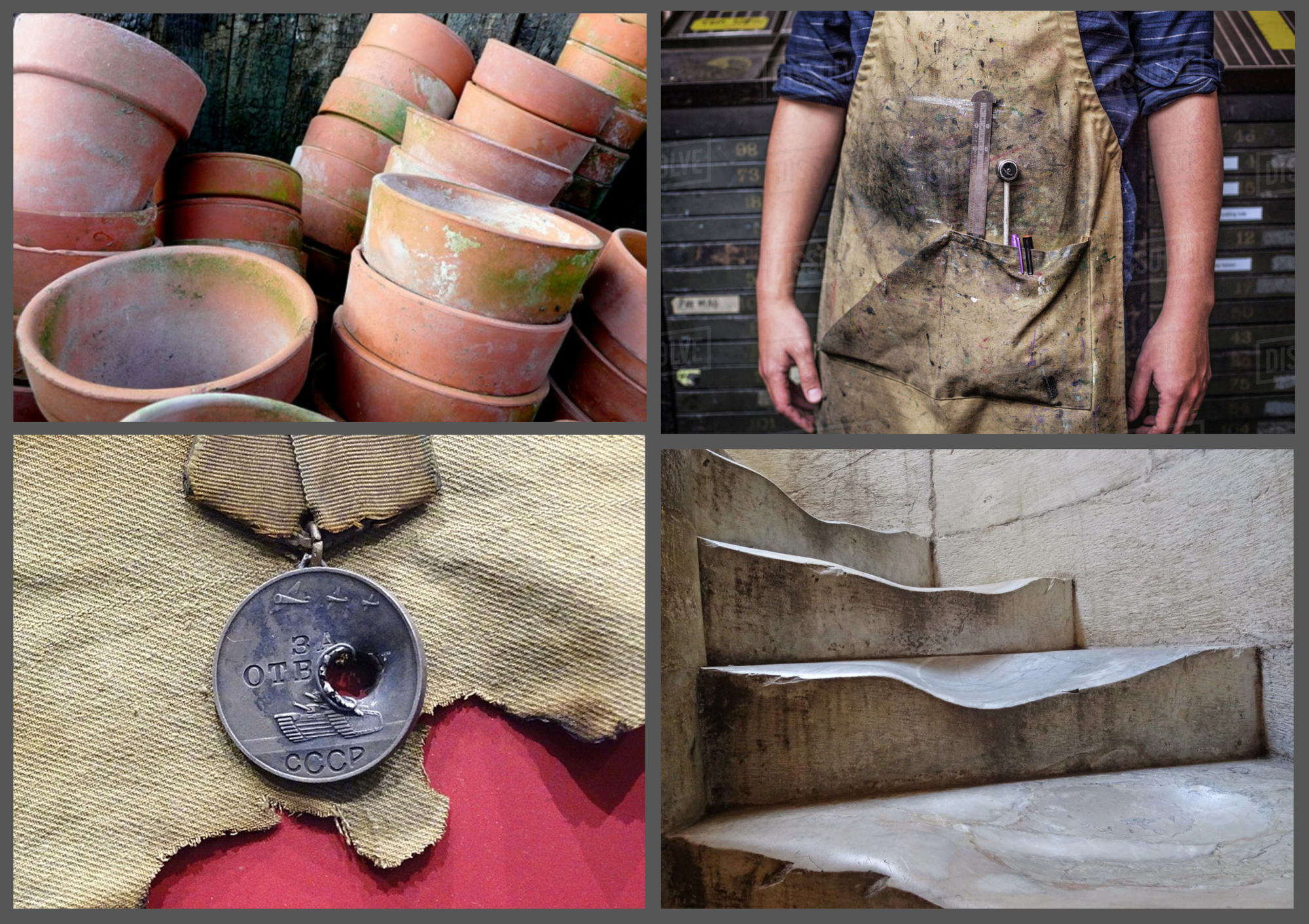
Storytelling is an incredibly important part of our work. It’s who we are; it’s what we do. When working on an asset, imagine yourself in the place of a person who used this item, or imagine yourself in a place that you want to create.
What happens to this object and what events occur in this place? How do they affect it? It may be as simple as a number written on the side of the item with a sharpie. A piece of duct tape that covers the crack, payphone buttons that rub out from extensive overuse.
- Here are some examples of subtle storytelling from the Book scene

1. This is a unique one-of-a-kind object that draws heavily from medieval metal-bound books. Hinges would probably be hand-made; they would probably sustain some damage because the world of Sanctuary is a violent place. Overall, they wouldn’t be straight and even.
2. Numerous dents and nicks to the metal surface. Notice how central indentations have a larger softer dip around them. That does happen to metal when it’s struck head-on. You have the main indentation where metal is compressed heavily and you have an area of bending due to excessive force.
3. Straightforward, ink drop. Chances are when writing in ink, you’d try to use the edge of the container to take off the excess liquid in order to prevent messiness on the page. Sometimes if you’re not careful, it can overflow and drip down.
4. There’s some wash shading around the cube to help it pop on the page. Maybe someone who did this wash hasn’t dried the brush properly and it left a drop at some point. These things happen. These examples are just the tip of the proverbial iceberg. There’s a lot you can do to add history and flavor to your assets.
- Below are some real-life counterparts for the elements of the book.
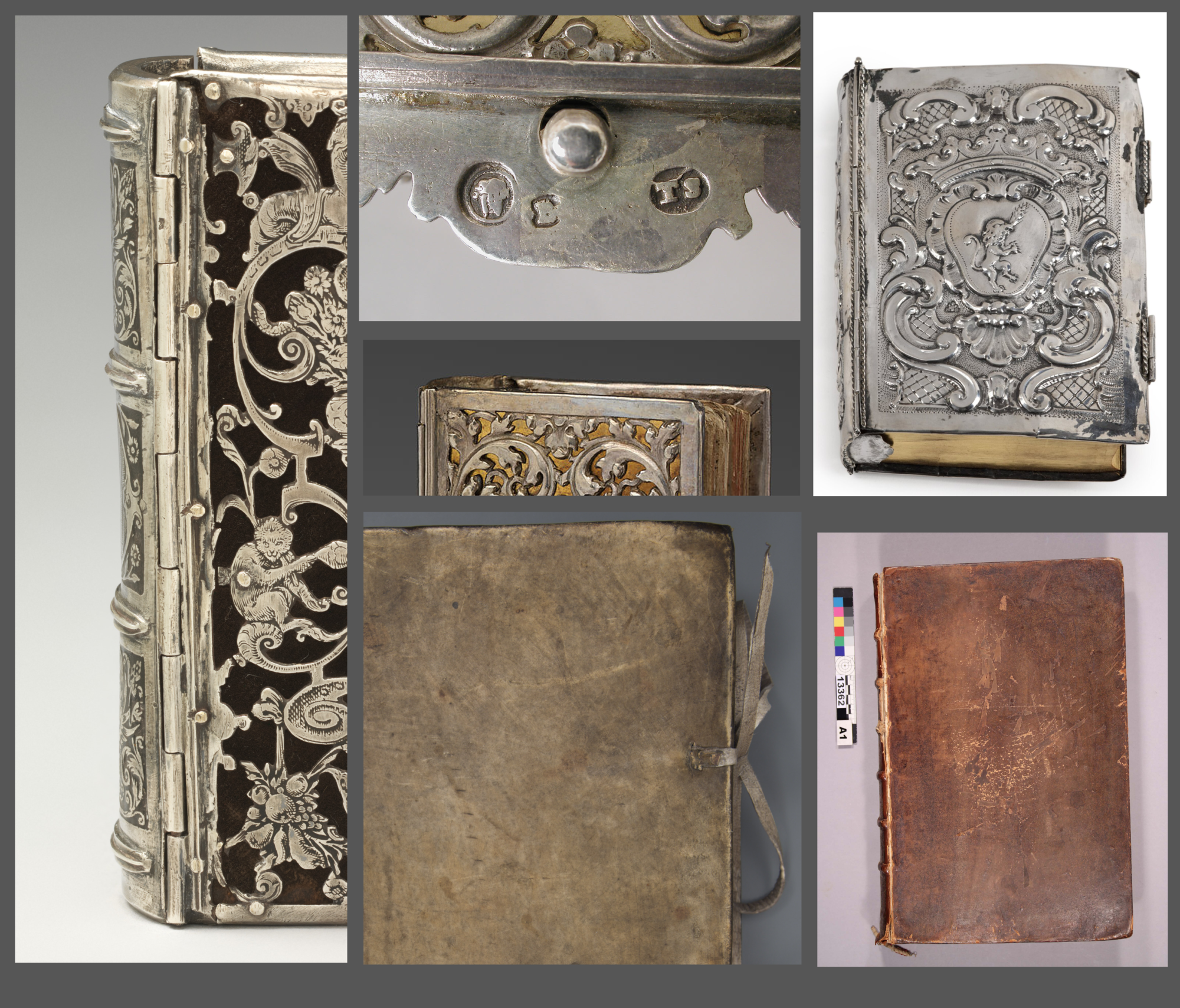
Rendering
Many 3D Artists get trapped in wanting to showcase every inch of their artwork equally. And for good reason. You put your heart and soul into it; you’d want people to see every little detail, every nook and cranny, and not miss a single thing that you worked so hard on.
At first, I wanted to present my book with what I figured would be the most “revealing” angle. Top down with direct lighting. But I am lucky enough to have people in my life to forestall me from making silly mistakes.
After some feedback, I’ve decided to completely change the direction and create a scene filled with additional props that would allow me to display my pièce de résistance in a more appealing setting.
- Below is the initial rendering setup, pretty meh.
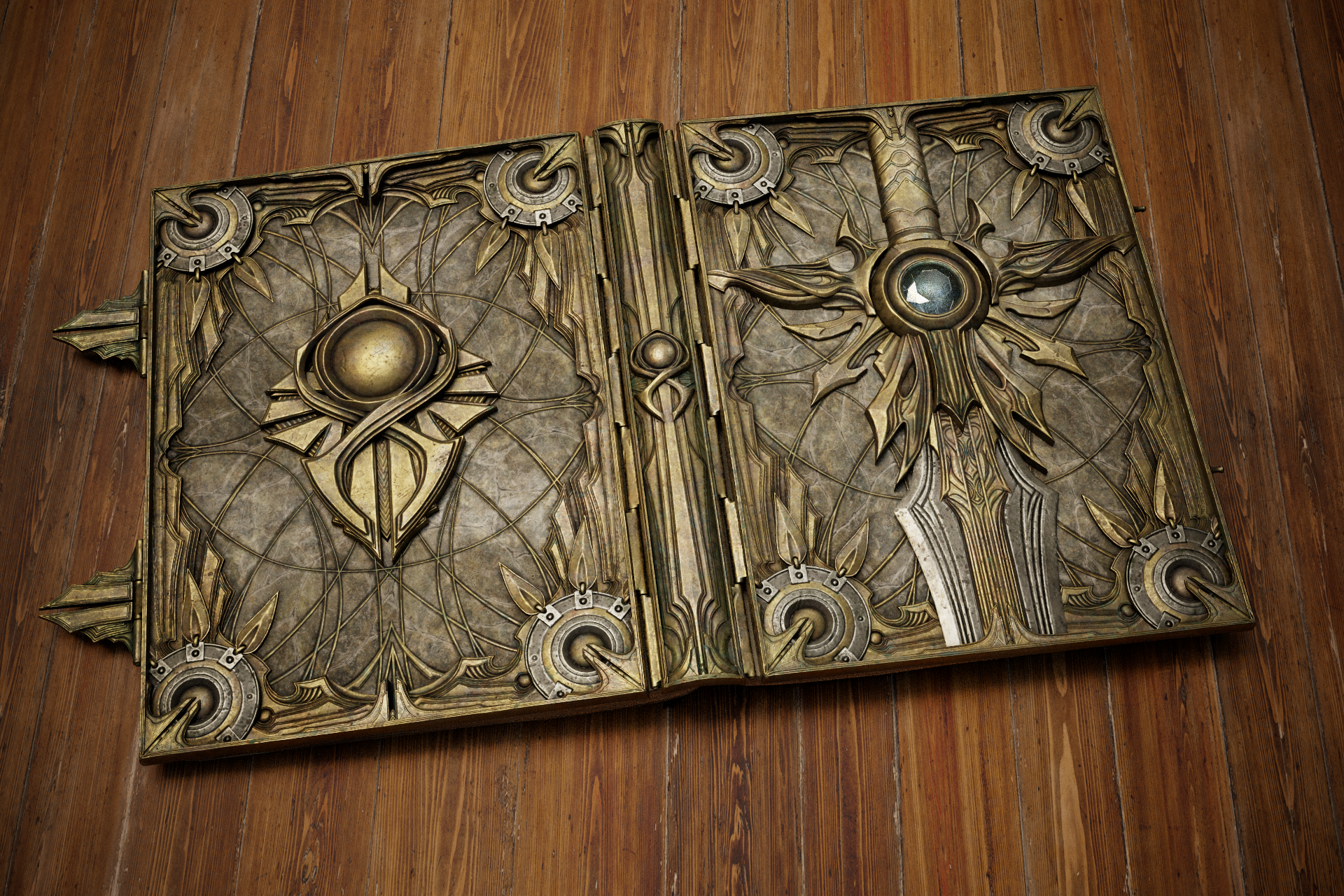
After much deliberation and looking at Diablo 3 Cinematics, I’ve settled on a scene and composition, loosely based on the framework of The Black Soulstone cinematic.
- Below are screenshots from The Black Soulstone cinematic.

I went back and rather quickly dished out some additional props, assigned them a separate material, and got to texturing. Wooden stands, candles, candleholders and the inkwell with quill were all created for set dressing and creating atmosphere.
And then I figured, hey, why not create a font for an open version? It’s there in the movie, isn’t it? So I started trying different ways to create a hand-written font, that would look appropriate. I’ve tried using medieval ciphers from historical pieces like Voynich Manuscript and Commentarii nostrum tironianarum, but they looked silly in the context of this book.
I’ve also tried some AI-generated handwriting, but those were essentially in English, albeit looking realistically handwritten. I even delved into studying fictional scripts from languages like Sindarin, Klingon et al.
All of it looked out of place. In the end, I used the most obvious solution. I’ve taken the screenshot of the book from the cinematic, created a straightened version, and started overpainting it, trying to be as flowy as possible.
The first few tries were kinda wonky, but after some time I got into the groove of it and started improvising. It took some time, but after creating a good chunk of text I went ahead and started mixing and combining different phrases in Photoshop and soon had a whole page of text.
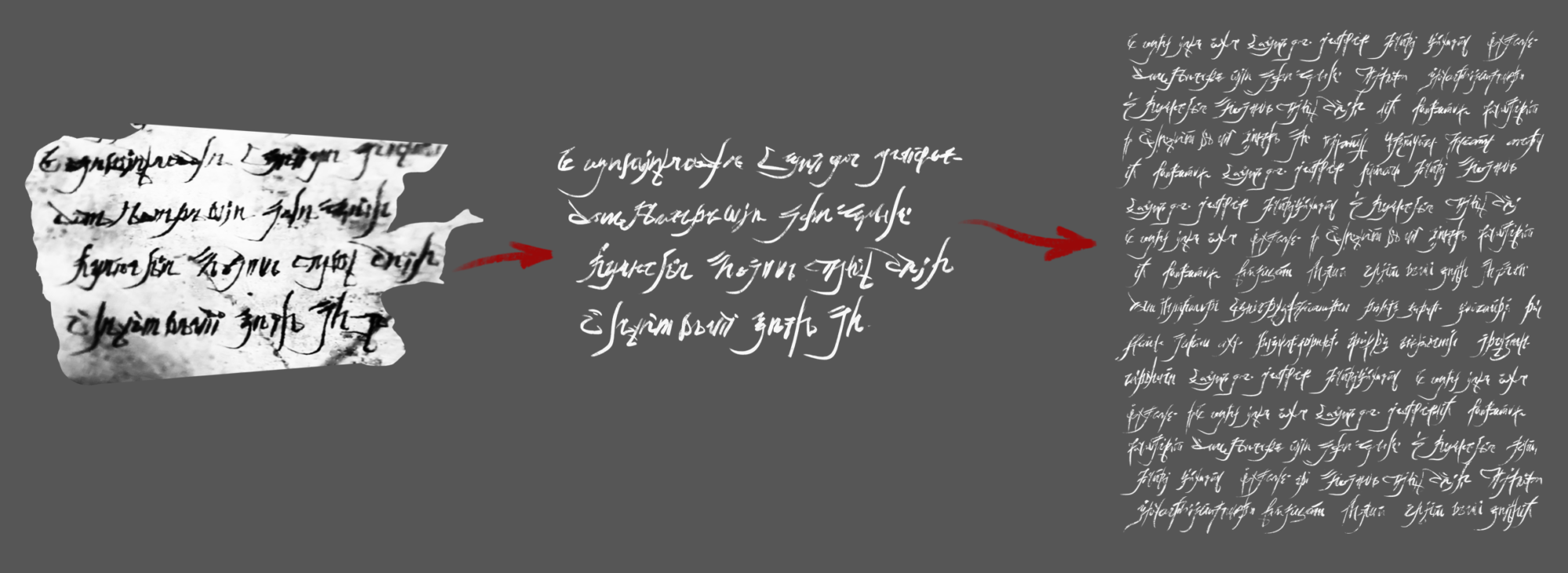
I’m not the best person to tell you about lighting and rendering. Honestly, it’s all a lot of trial and error for me. I’m not fancy like most of the people who tell you about key lights and fill lights. I generally go with what feels right.
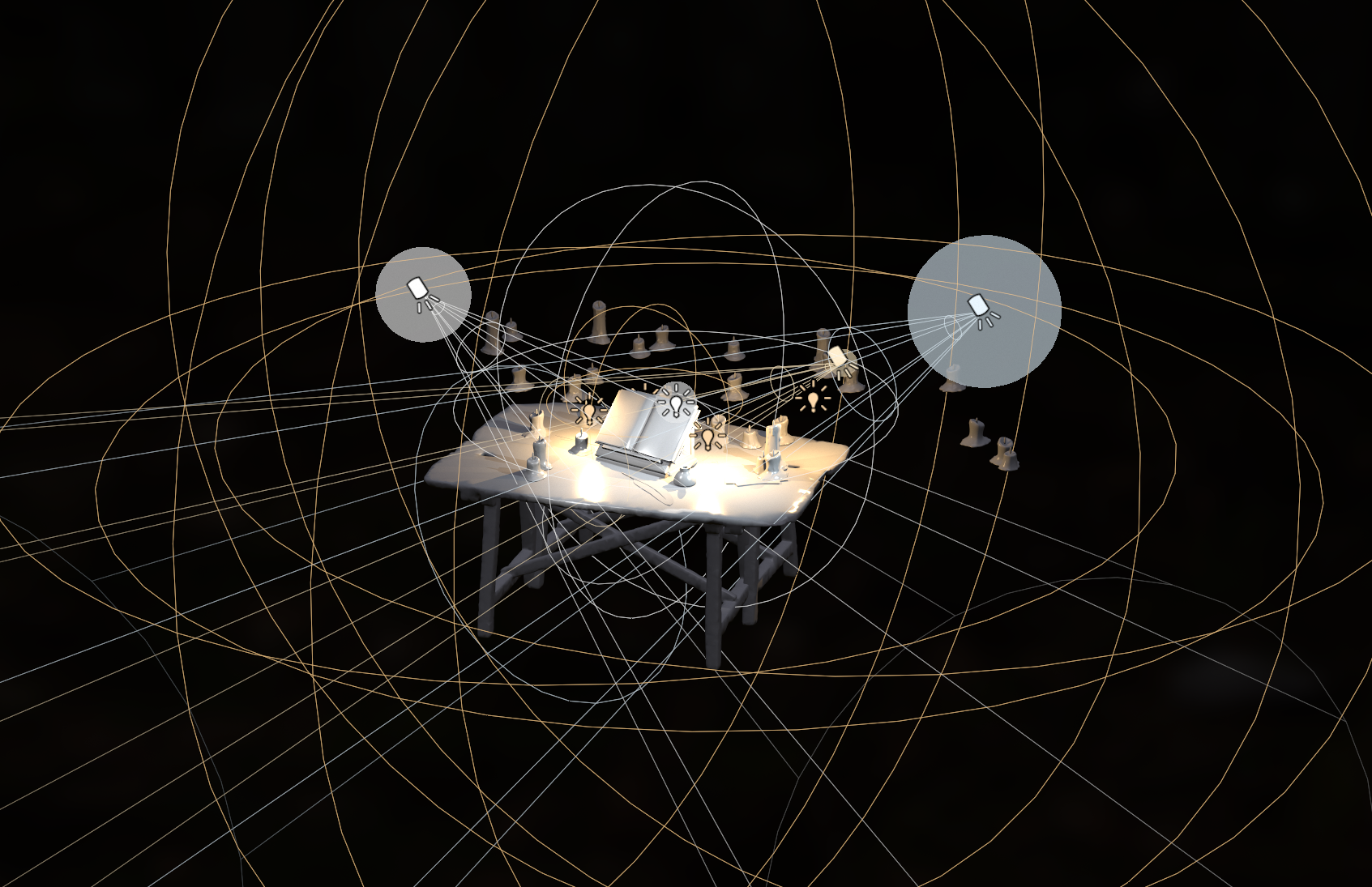
Try to avoid the sharp edges of your shadows; they create unnecessary shapes and rhythm and draw attention. You know, unless that is your intention.
Try to paint with light by creating accents and areas of interest, while keeping areas of visual rest. Moderation is key in everything, and if everything in your scene is equally special, then nothing actually is. Here are some examples of areas of interest in a scene.
Depth of field also helps frame things. You still have the ambient atmosphere around the object, but it’s not distracting the eye from the key focus point.
- Below are some examples of points of interest in the scene.
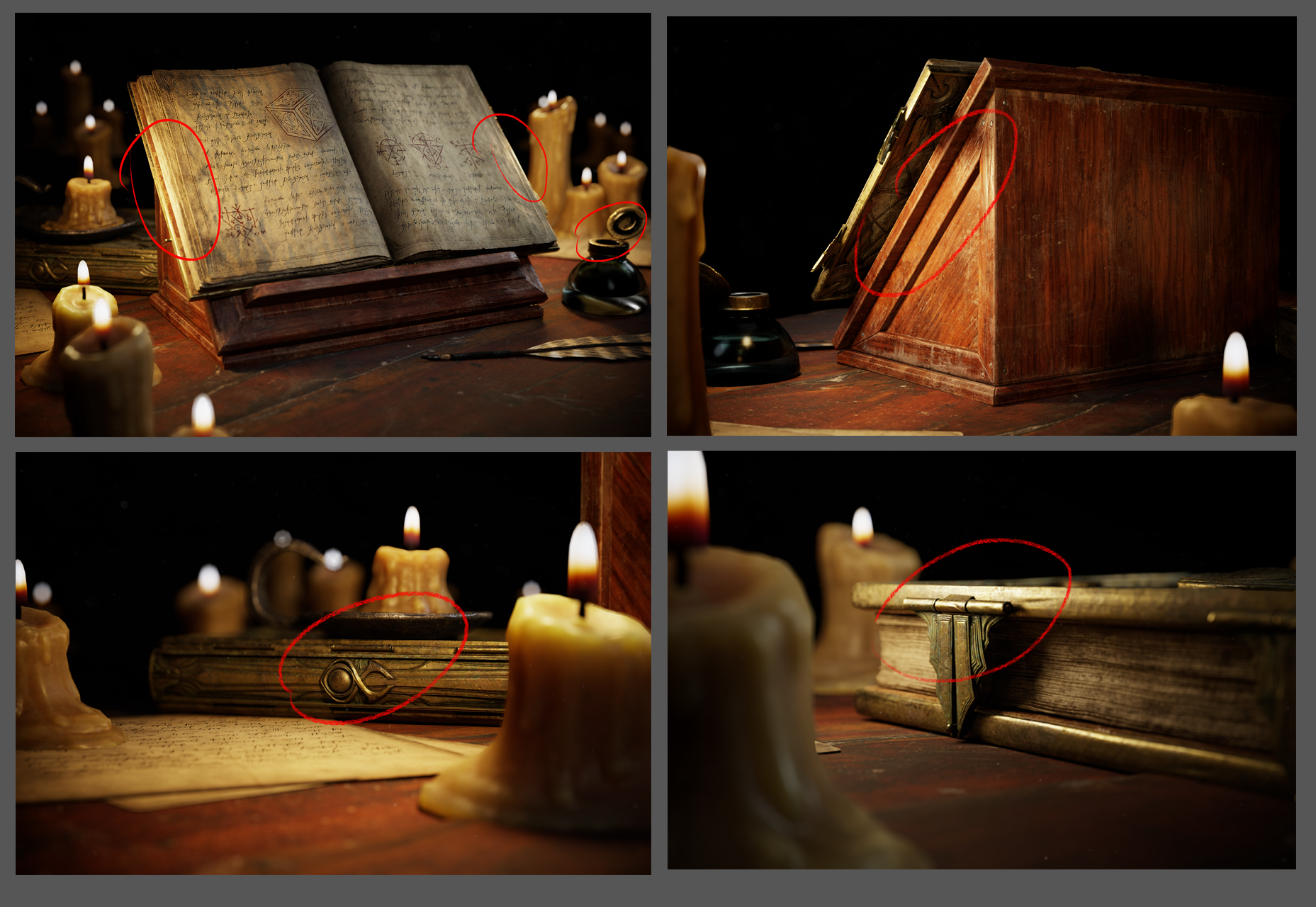
Tips and tricks
In this section, I want to go over a few nifty things I used over the course of this production. They mostly revolve around Substance Painter, so here goes.
1. Anchors
It’s hard to overestimate the usefulness of Anchors when working in Substance Painter. When you stamp something on the metal, for example, the material is displaced and there’s a small raised lip around the divet.
Simply put an anchor on top of your indentation mask and create another layer with a black mask where you put the anchor into a filled node, blur it out, and add another fill node with the same anchor in Subtract mode. This creates a soft outline around your indentation that can serve as a raised lip or as a bent dip. Or both, if you’re fancy like that.
There are plenty of cases where anchors can be useful; keep this feature in mind.
- Below we have the material with raised edge around the mask and dented damage on the surface
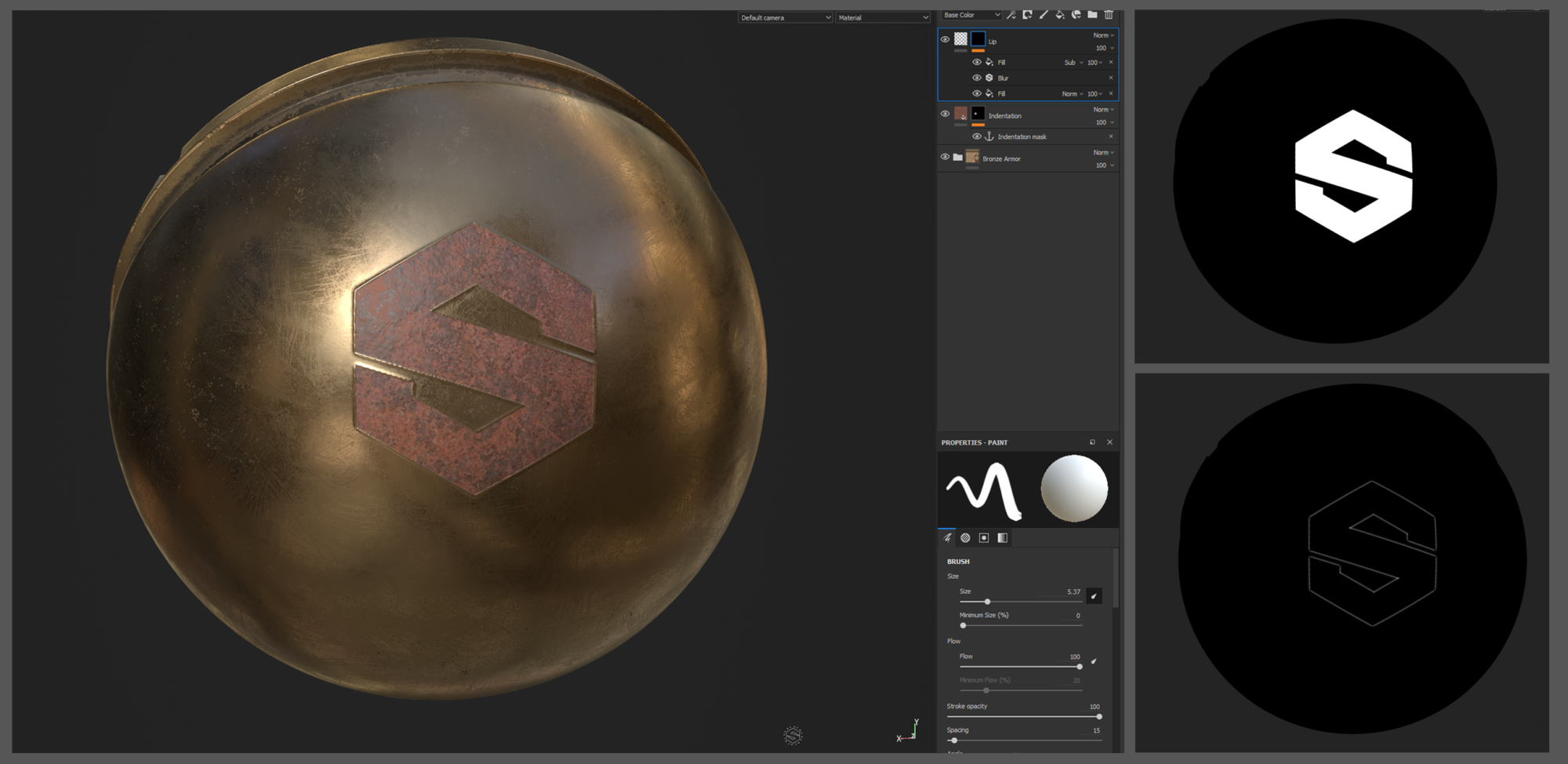
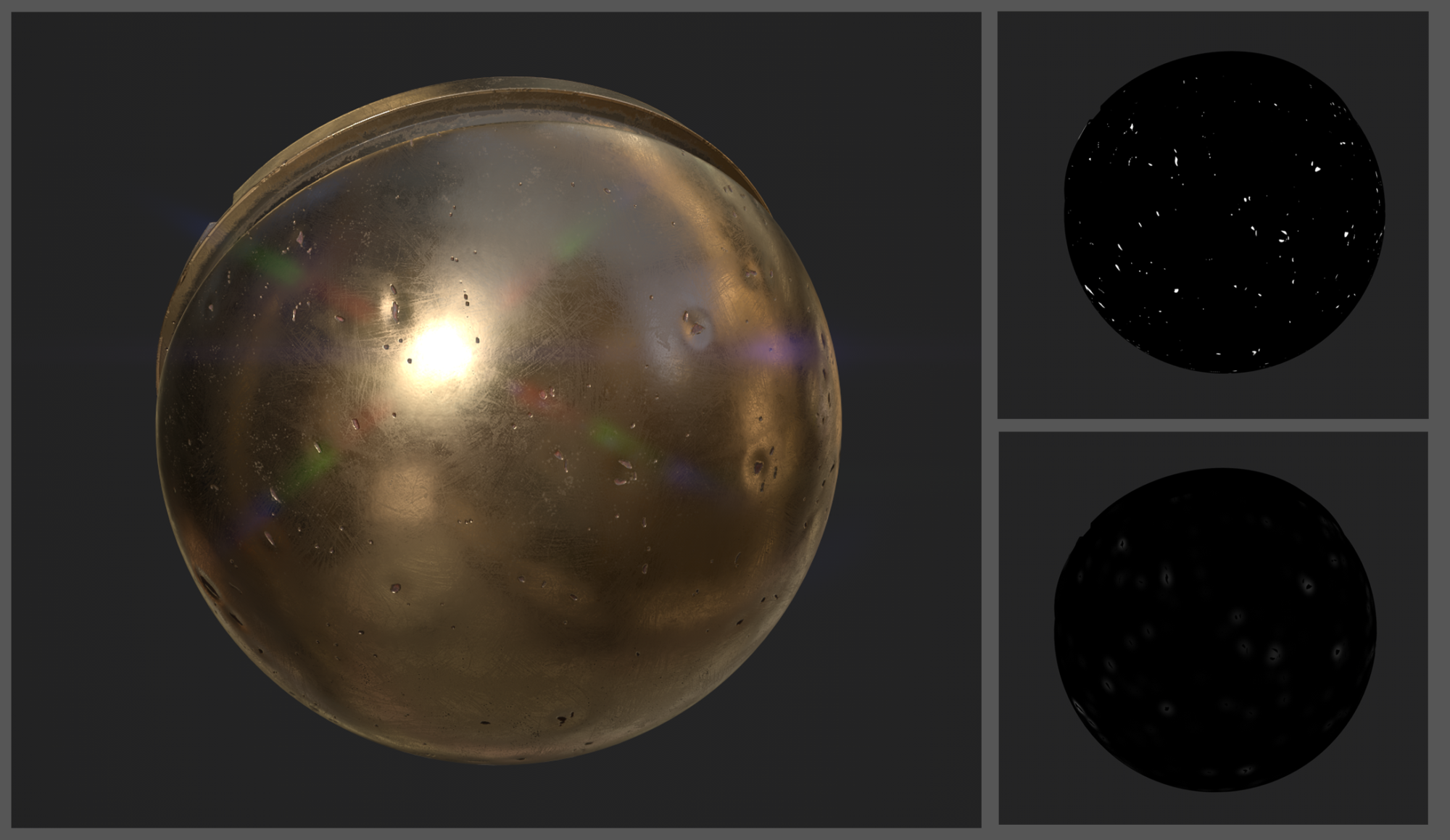
2. Blur+Histogram Scan
There are times when you need to make your mask a little bit tidier. Or simplify it if you’re working on something more stylized. In such cases I’ve stumbled into a combination of filters, that kind of does that.
Maybe it’s out there online, but I haven’t seen it myself. This combination also helps a lot when you have a low-res ID mask and the edge is looking somewhat frayed. Add these filters on top your Color Selection and play around with settings to clean it up.

3. Highpass
This one is also pretty straightforward. If you want to add a highpass to your textures, you might struggle to do so with the built-in filter, since it’s intended to work with masks. At least I found it to be so.
One of the ways you can apply it to your textures to add some visual sharpness is by utilizing an anchor.

1. Create a paint layer, add a Highpass filter.
2. Set the blending mode to Passthrough.
3. Add an Anchor, create a Fill layer, and reference this Anchor into the material slot. Set the Fill layer’s blending mode to Overlay and hide the initial Paint layer.
Now you have a working Highpass filter on your textures, you can combine these layers into a folder, set the folder’s blending mode to Passthrough, and save it as Smart material. Now you can drop it into your layer stack whenever.
Conclusion
I hope that this article has been useful to you. Thank you for your attention and have fun doing art!



